 I take time to listen to the sunset. Sitting next to quivering cattails, at the edge of the marsh at the Watershed Reserve, I listen to a shifting symphony. An occasional green frog offers an advertising call – a hard swallow, a loud “GULP” – aimed at enticing a female. Behind me, from beneath a split log, a field cricket has the same intent, chirping cheerfully and musically. The main performers in this movement, however, are the boisterous redwing blackbirds.
I take time to listen to the sunset. Sitting next to quivering cattails, at the edge of the marsh at the Watershed Reserve, I listen to a shifting symphony. An occasional green frog offers an advertising call – a hard swallow, a loud “GULP” – aimed at enticing a female. Behind me, from beneath a split log, a field cricket has the same intent, chirping cheerfully and musically. The main performers in this movement, however, are the boisterous redwing blackbirds.
The blackbirds are busy making use of the last light of day. Their musical conversations fill the air as they assert territorial boundaries, strengthen pair bonds and grab a last meal for the day. The handsome males are coal black with scarlet red epaulets, shoulder patches on their wings. They make a variety of sounds but most notably, their iconic song of the marsh, “Conk-areee”, with an upward inflection. The camouflaged female, with streaks of brown, like dead grass, adds her insistent multisyllabic screeching.
I enjoy the outdoor performance, this night, a marsh symphony. The bright light of Venus floats in the western sky as nightfall, and business, lure me toward the woods. I find great value in spending time in the wild, and I shared this experience through Facebook Live for viewers on the Watershed Institute page.
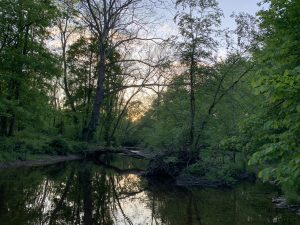 I’ve always had an insatiable appetite for the wild, for nature. I grew up amidst fallow farm fields in rural Hopewell Township with an endless expanse of state park in my backyard. Like other children around me, we relished our time in the wild. Clearly some evolutionary memory must draw us to nature, where for most of our journey as a species we made a home, found food and all the other resources necessary for survival.
I’ve always had an insatiable appetite for the wild, for nature. I grew up amidst fallow farm fields in rural Hopewell Township with an endless expanse of state park in my backyard. Like other children around me, we relished our time in the wild. Clearly some evolutionary memory must draw us to nature, where for most of our journey as a species we made a home, found food and all the other resources necessary for survival.
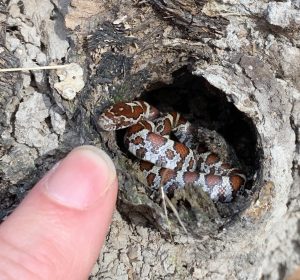
Little did we know back then how well our time in the wild was serving us. Marine biologist and best-selling author Rachel Carson celebrated nature’s role in fueling a child’s sense of awe in her 1956 essay “Helping Your Child to Wonder”, posthumously published as The Sense of Wonder. In Last Child in the Woods, published in 2005, Richard Louv showcased a vast amount of research indicating that direct contact with nature is essential for healthy childhood development as well as for the overall health of children and adults. Research from universities throughout the nation indicates that exposure to nature reduces stress, clears the mind, and increases energy.
While my childhood friends started to drift, one by one, away from the magic of nature, I never lost that connection. It only strengthened over time. Nature has an obvious capacity to engage, captivate, mystify and charm, and it did just that for me. It stimulates not just the sense of wonder but the imagination as well. Over the years my enjoyment of nature has taken many forms and, in no particular order, it includes hiking, biking, bird watching, climbing, adventuring, writing, fishing, spelunking, bug catching, tree climbing, tree hugging, sketching, creek dipping, photography, wildflower watching, and yes, much more.
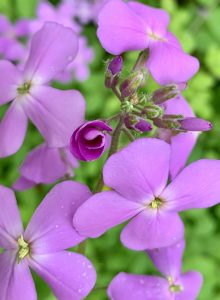 Though I have been guilty of countless episodes of focused, almost tactical nature exploration, my preferred way to enter the wild is without agenda, and with complete reverence. I call it communing. To commune with nature is to experience a strong emotional upwelling, a fullness of the heart, a spiritual surge. Despite a love for high adventure, naturalist and conservationist John Muir (1838 – 1914) favored this by another name, sauntering, a relaxed, leisurely walk. “We ought to saunter through (the mountains) reverently,” he said in an interview, “not hike through them.” This sense of reverence is at the center of my communing.
Though I have been guilty of countless episodes of focused, almost tactical nature exploration, my preferred way to enter the wild is without agenda, and with complete reverence. I call it communing. To commune with nature is to experience a strong emotional upwelling, a fullness of the heart, a spiritual surge. Despite a love for high adventure, naturalist and conservationist John Muir (1838 – 1914) favored this by another name, sauntering, a relaxed, leisurely walk. “We ought to saunter through (the mountains) reverently,” he said in an interview, “not hike through them.” This sense of reverence is at the center of my communing.
I find great joy in meeting and getting to know my “natural neighbors”, spending time with the plants, animals and others in the world of nature around me. I am drawn to their beauty, mystery and especially, their story. I suffer from incurable biophilia. Biologist E.O. Wilson used this word to describe the tendency of humans to affiliate with other organisms. He went further, in Biophilia, published in 1984, to attribute a genetic component.
You too can discover this joy, gaining a broader perspective of the community of life all around you. This is easy to do, doesn’t take much time, but may require some practice. Start by surrendering agenda, just for a short time. Try to just “be” in the outdoors. Slow down and embrace the sensory inputs that your body provides.
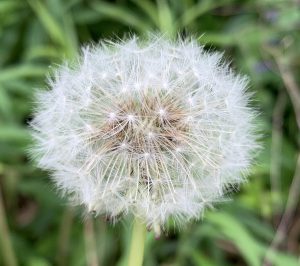
We are visual creatures so start by looking, really seeing, what is around you. Your other senses need attention as well. Smell the citrusy spicebush, listen to the fluting wood thrush, and feel soft succulent leaves of jewelweed. Over time, with some study, you can discover and taste some of the many plants that sustained us many generations ago in the wild.
In addition to engaging your senses, broaden your perspective. Consider, for instance, the weed that grows in your yard. Do what you may with that plant but first, stop, observe, and reflect. You are allowed to admit admiration for the minty tenacity of ground ivy creeping through your lawn, or the fleeting seed-blossom of dandelion. Don’t see it? Ask any young child.
Many of us have heard tales from friends or in the media about the increase of wildlife, suddenly appearing in our communities during the COVID-19 crisis. Wildlife populations are not likely increasing however some species may be taking advantage of the spaces and quiet we have provided during our shutdown. It is also likely that during this time, we have slowed down, perhaps surrendered some of our agenda, and begun observing what is right around us.
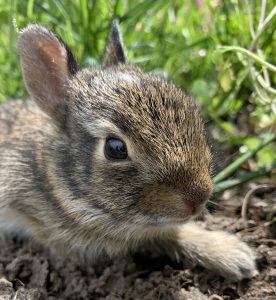
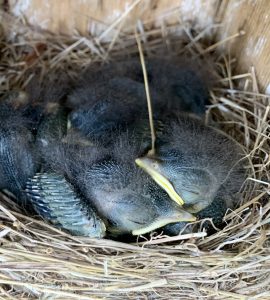 Step outside with intent – meet the residents, in your backyard, in your neighborhood, in your community park. Watch for family life right before you – the hungry robin fledglings, and the hidden nest of huddled rabbits. With a sense of wonder, meet the gray tree frog, camouflaged on the bark of a tree. Keep that sense of wonder when you spy the garter snake slithering into the shadows from the sunny trailside or hear the howling and yipping of the coyote party at the edge of town. Isn’t it time to appreciate our neighbors?
Step outside with intent – meet the residents, in your backyard, in your neighborhood, in your community park. Watch for family life right before you – the hungry robin fledglings, and the hidden nest of huddled rabbits. With a sense of wonder, meet the gray tree frog, camouflaged on the bark of a tree. Keep that sense of wonder when you spy the garter snake slithering into the shadows from the sunny trailside or hear the howling and yipping of the coyote party at the edge of town. Isn’t it time to appreciate our neighbors?

Jeff Hoagland is the longtime Education Director at the Watershed Institute in Pennington, NJ where the mission is to keep water clean, healthy and safe. He shares his passion for the natural world and examines our place in it, through his work at the Watershed Institute; his daily travels; and through his internationally published haiku.
